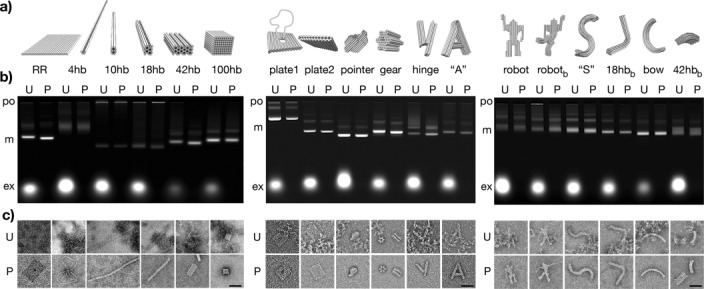Figure 1.

PEG purification of a library of DNA origami objects. a) Illustration (RR to 100 hb) and CanDo-computed20 models (plate1 to 42 hbb) of a panel of DNA objects comprising a variant of Rothemund’s single-layer DNA rectangle (RR)2a and five multilayer objects (four-, ten-, 18-, or 42-helix bundle in honeycomb lattice design; 100-helix bundle in square lattice design),9 a plate-like object with aperture and double-stranded loop (plate1),4c a plate-like object (plate2),4c an asymmetric 82-helix bundle in square lattice design (pointer),2h a gear-like object (gear),18 a flexible hinged-bar object (hinge),18 a letter-A-like object (“A”),20b a straight and bent version of a robot-like object (robot, robotb),20 a letter-S-like object (“S”),20b a bow-like object (bow),20b and bent versions of an 18-helix bundle and a 42-helix bundle (18hbb, 42hbb).2c, 18 The library of objects thus samples a wide spectrum of shapes, aspect ratios, and mechanical properties. b) Images of agarose gels on which unpurified self-assembly reaction mixtures (U) and PEG purified samples (P) of the objects listed above in (a) were electrophoretically separated. Labels: po, gel loading pocket; m, properly folded monomers; ex, non-integrated excess staple strands. c) Exemplary TEM micrographs of single particles in unpurified reaction mixtures (U) and PEG-purified samples (P). Scale bars: 50 nm.
